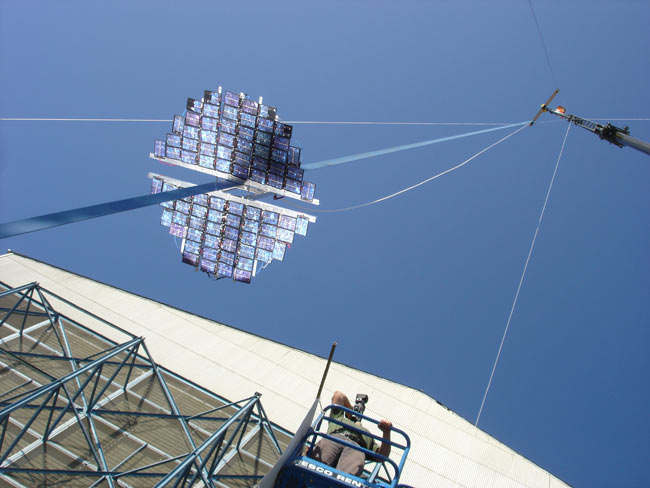Space Elevator Contest Heats Up

Pull me up, Scotty. At least one team has qualified for partof a $2 million prize up for grabs in this year's Space Elevator Games, aNASA-sponsored contest to build machines that can climb a cable in the sky ? precursorsfor a futuristic transit system to space.
On Wednesday, an entry by the Washington state-based team LaserMotiveclimbed a 3,000-foot (900-meter) tether suspended by a helicopter at a speed ofabout 8 mph (13 kph). The feat was the best performanceyet of a miniature space elevator prototype, though still a long shot awayfrom what would be needed to carry humans to Earth orbit, as proponentsenvision.
The competition, called the Power Beaming Challenge, is being held this week at NASA's Dryden FlightResearch Center at Edwards Air Force Base in the California desert. It requires competitors to beam power from a remote source to propell their vehicles upward.
Spaceelevators were first popularized in the 1970s by the science fiction novelsof Arthur C. Clarke, as a means to reach space without using a rocket. Instead,a ship could climb along a fixed structure, like a beam or cable, suspended inspace by a permanent geostationary satellite 22,000 miles (35,000 km) aboveEarth. The sticking points are the need for a super-strong, yet light, materialfor the tether, and a good way to anchor the other end securely. Not to mentionthe vehicle to climb it.
That's where the Space Elevator Games come in. Today offersa second chance for more climbers to compete, and any team that can power theirentrant for an average speed of 11 mph (18 kph) will qualify for a portion ofthe total $2 million prize purse on offer. The competition is sponsored by theSpaceward Foundation and NASA's CentennialChallenges program aimed to spur development in space exploration.
An attempt by the Kansas City Space Pirates on Wednesdayfell short of the speed requirement. The climber from USST (University ofSaskatchewan Space Design Team) is slated to compete today.
- Video - Star Trek's Warp Drive: Are We There Yet?
- Space Elevator: Hoist to the Heavens
- X-Prize Space Elevator Race Ends With No Winners
Breaking space news, the latest updates on rocket launches, skywatching events and more!

Clara Moskowitz is a science and space writer who joined the Space.com team in 2008 and served as Assistant Managing Editor from 2011 to 2013. Clara has a bachelor's degree in astronomy and physics from Wesleyan University, and a graduate certificate in science writing from the University of California, Santa Cruz. She covers everything from astronomy to human spaceflight and once aced a NASTAR suborbital spaceflight training program for space missions. Clara is currently Associate Editor of Scientific American. To see her latest project is, follow Clara on Twitter.
